Renewable Energy Community Pairing Methodology Using Statistical Learning Applied to Georeferenced Energy Profiles
Abstract
:1. Introduction
1.1. Landscape and Regulatory Framework
- Consumption and sharing: the energy produced by the energy community is shared and used inside the community, often called self and collective consumption of electricity from the co-owned generating resources.
- Supply: the sale of electricity and gas to customers. Often, larger communities, which have a high number of retail customers in their vicinity, may also engage in aggregation activities, combining load flexibility or generation to bid, purchase or auction in electricity markets [4].
- Distribution: ownership and/or management of community distribution networks, including electricity, district heating, or gas networks. Cooperatives may participate in generation and distribution, but their central business is the network infrastructure [5].
- Generation: from co-owned assets such as solar, wind, or hydro, where members do not self-consume the energy produced but instead feed it into the network and sell it to a supplier [6].
- Energy services include projects for the renovation of buildings, energy auditing, consumption monitoring, heating, and air quality assessments for energy efficiency. It may extend to smart grid integration, energy monitoring, and energy management for network operation.
- Electro-mobility: Services promoting car sharing, charging stations operation and management, or provision of EV cards for members and cooperatives.
1.2. Renewable Energy Community in Research
1.2.1. Asset Dimensioning and Optimization
1.2.2. Social-Economic Impact Evaluation of REC
1.2.3. Specification and Development of New Algorithms for REC and Efficient Operations
- -
- A brief revision of the main categories of research addressing REC
- -
- Methodology presentation for pairing REC members based on clustering
- -
- Case study presentation to apply the methodology
- -
- Verification of complementarity potential using pairing examples from the case study.
2. Methodology
2.1. Renewable Energy Communities Paring
- The users’ consumption profiles are similar, and they overlap very well with the existent generation amplitude and hours. In this case, unless there are economies of scale and other investment synergies, users would not need to be in a REC as no surplus exist and most of the potential auto consumption is satisfied individually.
- There are different load consumption profiles (peaks and valleys in different hours), whose difference does not improve auto-consumption. This can happen if a generation profile serves some consumer(s), but the surplus generation does not serve other(s) different user consumption profiles. This can happen if there is a mismatch with generation hours, such as night hours, which is unlikely especially if users in the same category are considered (residential, commercial, industrial, services, etc.). However, it depends on the assets dimensioned for the REC. If storage exists, then such profiles could be complementary as they can consume the stored electricity at different timings, but with a higher cost of infrastructure.
- There are different load consumption profiles (peaks and valleys in different hours), whose differences improve the auto-consumption by capturing the generation hours and surplus that other consumer(s) cannot, which in practice is the most likely scenario to happen.
2.2. Case Study: Asprela
2.3. Supervised and Unsupervised Models
3. Results and Discussion
4. Conclusions
Author Contributions
Funding
Institutional Review Board Statement
Informed Consent Statement
Data Availability Statement
Conflicts of Interest
References
- European Commission. Clean Energy for All Europeans Package—European Commission. 20 October 2017. Available online: https://ec.europa.eu/energy/en/topics/energy-strategy/clean-energy-all-europeans (accessed on 2 February 2022).
- Communication from the Commission to the European Parliament; The European Council. The European Economic and Social Committee and the Committee of Regions; The European Green Deal COM/2019/640 Final; Office for Official Publications of the European Communities: Brussels, Belgium; Luxembourg, 2019; p. 24. [Google Scholar]
- Caramizaru, A.; Uihlein, A. Energy Communities: An Overview of Energy and Social Innovation; JRC Report 119433; Publications Office of the European Union: Luxembourg, 2020; p. 9. [Google Scholar] [CrossRef]
- European Council. Directive (EU) 2019/944/EC of the European Parliament and of the Council of 5 June 2019 concerning common Rules for the Internal Market for Electricity. Off. J. Eur. Union 2019, L 158/125, 75. [Google Scholar]
- Yildiz, Ö.; Rommel, J.; Debor, S.; Holstenkamp, L.; Mey, F.; Müller, J.R.; Radtke, J.; Rognli, J. Renewable energy cooperatives as gatekeepers or facilitators? Recent developments in Germany and a multidisciplinary research agenda. Energy Res. Soc. Sci. 2015, 6, 59–73. [Google Scholar] [CrossRef]
- Council of European Energy Regulators, Regulatory Aspects of Self-Consumption and Energy Communities, CEER Report C18-CRM9_DS7-05-03. June 2019; p. 53. Available online: https://www.ceer.eu/documents/104400/-/-/8ee38e61-a802-bd6f-db27-4fb61aa6eb6a. (accessed on 14 March 2022).
- ETIP SNET R&I Roadmap 2020–2030 (Updated 02/2020). Available online: https://www.etip-snet.eu/etip_publ/etip-snet-ri-roadmap-2020-2030/. (accessed on 14 March 2022).
- Boulanger, S.O.M.; Massari, M.; Longo, D.; Turillazzi, B.; Nucci, C.A. Designing Collaborative Energy Communities: A European Overview. Energies 2021, 14, 8226. [Google Scholar] [CrossRef]
- NRG2Peers. Available online: https://nrg2peers.com (accessed on 12 February 2022).
- D’Oca, S.; Breukers, S.; Slingerland, S.; Boekelo, M.; van Welie, M.J.; Moscardi, C.; Aggeli, A.; Burgstaller, K.; Coosemans, T.; Hueting, R.; et al. A Social Engagement Fast Track on Energy Communities—Key Lesson Learned from H2020 EU Projects. Environ. Sci. Proc. 2021, 11, 17. [Google Scholar] [CrossRef]
- MERLON. Available online: www.merlon-project.eu (accessed on 12 February 2022).
- Papadaskalopoulos, D.; Woolf, M.; Chrysanthopoulos, N.; Strbac, G. Business models and barriers towards the development of local energy systems in europe: Insights from the merlon project. In Proceedings of the CIRED 2021—26th International Conference and Exhibition on Electricity Distribution, Online Conference, 20–23 September 2021; pp. 3269–3273. [Google Scholar] [CrossRef]
- Luz, G.P.; E Silva, R.A. Modeling Energy Communities with Collective Photovoltaic Self-Consumption: Synergies between a Small City and a Winery in Portugal. Energies 2021, 14, 323. [Google Scholar] [CrossRef]
- Salvatore, R.; Aljosa, I.; Henner, B.; Karoliina, A.; Faller, F. Co2mmunity Working Paper 2.3-Developing a Joint Perspective on Community Energy: Best Practices and Challenges in the Baltic Sea Region; Lund University: Lund, Sweden, 2019; 34p. [Google Scholar]
- CIRCE. Available online: www.fcirce.es/en/horizon-2020 (accessed on 12 February 2022).
- BENEFFICE. Available online: www.beneffice.eu (accessed on 12 February 2022).
- Protopapadakis, E.; Doulamis, A.; Kaselimi, M. Changing User’s energy consumption behavior using IOT. In Proceedings of the 7th International Symposium & 29th National Conference on Operational Research, Chania, Greece, 14–16 June 2018. [Google Scholar]
- Garbi, A.; Malamou, A.; Michas, N.; Pontikas, Z.; Doulamis, N.; Protopapadakis, E.; Mikkelsen, T.N.; Kanellakis, K.; Baradat, J.-L. BENEFFICE: Behaviour change, consumption monitoring and analytics with complementary currency rewards. In Proceedings of the Sustainable Places Conference 2019, Cagliary, Italy, 5–7 June 2019. [Google Scholar]
- Launonen, H.; Tisov, A.; Germini, A.M.; Olivadese, R.; Koroleva, K.; Lukasik, M.; Malamou, A.; Arabsolgar, D.; Zacharis, E.; Garbi, A. Exploitation of the European Research Projects Aiming to Achieve a Behavior Change for Energy Saving Through Innovative IT Solutions. In Proceedings of the Sustainable Places Conference 2019, Cagliary, Italy, 5–7 June 2019. [Google Scholar]
- Social Res. Available online: https://socialres.eu (accessed on 12 February 2022).
- Wu, H.; Carroll, J.; Denny, E. Harnessing citizen investment in community-based energy initiatives: A discrete choice experiment across ten European countries. Energy Res. Soc. Sci. 2022, 89, 102552, ISSN 2214-6296. [Google Scholar] [CrossRef]
- LIGHTNESS. Available online: www.lightness-project.eu (accessed on 12 February 2022).
- Slingerland, S.; Young, J.; Mourik, R.; Lutz, L. Energy Communities for Just Energy Transitions on a Local Scale: Initial Lessons from the Lightness Project. Environ. Sci. Proc. 2021, 11, 29. [Google Scholar] [CrossRef]
- Renaissance. Available online: www.renaissance-h2020.eu (accessed on 12 February 2022).
- Lode, M.L.; Felice, A.; Ander, M.A.; De Silva, J.; Lopeze, M.E.; Lowitzsch, J.; Coosemans, T.; Camargo, L.R. Coupling Rural Development with the Development of Energy Communities: A Participatory Study in Vega De Valcarce, Spain; SSRN: Rochester, NY, USA, 15 April 2022. [Google Scholar] [CrossRef]
- Felice, A.; Rakocevic, L.; Peeters, L.; Messagie, M.; Coosemans, T.; Camargo, L.R. An assessment of operational economic benefits of renewable energy communities in Belgium. J. Phys. Conf. Ser. 2021, 2042, 12033. [Google Scholar] [CrossRef]
- Zhou, S.; Hu, Z.; Gu, W.; Jiang, M.; Zhang, X.-P. Artificial intelligence based smart energy community management: A reinforcement learning approach. CSEE J. Power Energy Syst. 2019, 5, 1–10. [Google Scholar] [CrossRef]
- Sismanidis, P.; Keramitsoglou, I.; Barberis, S.; Dorotić, H.; Bechtel, B.; Kiranoudis, C.T. PLANHEAT’s Satellite-Derived Heating and Cooling Degrees Dataset for Energy Demand Mapping and Planning. Remote Sens. 2019, 11, 2048. [Google Scholar] [CrossRef] [Green Version]
- Oregi, X.; Hermoso, N.; Prieto, I.; Izkara, J.L.; Mabe, L.; Sismanidis, P. Automatised and georeferenced energy assessment of an Antwerp district based on cadastral data. Energy Build. 2018, 173, 176–194. [Google Scholar] [CrossRef]
- Arnfield, A.; John. Köppen climate classification. In Encyclopedia Britannica, 11 November 2020. Available online: https://www.britannica.com/science/Koppen-climate-classification. (accessed on 14 March 2022).
- Censos. Available online: https://censos.ine.pt/ (accessed on 12 February 2022).
- Instituto Nacional de Estatística (INE). Censos 2011, Resultados Definitivos—Portugal. Report, INE Portugal 2012, p. 560, I.P., ISSN 0872-6493, ISBN 978-989-25-0181-9. Available online: https://censos.ine.pt/ngt_server/attachfileu.jsp?look_parentBoui=148313382&att_display=n&att_download=y (accessed on 12 February 2022).
- Chen, C.; Guestrin, T. XGBoost: A Scalable Tree Boosting System. In Proceedings of the 22nd ACM SIGKDD International Conference on Knowledge Discovery and Data Mining (KDD ‘16), San Francisco, CA, USA, 13–17 August 2016; pp. 785–794. [Google Scholar] [CrossRef] [Green Version]
- Giorgino, T. Computing and Visualizing Dynamic Time Warping Alignments in R: ThedtwPackage. J. Stat. Softw. 2009, 31, 1–24. [Google Scholar] [CrossRef] [Green Version]
- Presidência do Conselho de Ministros. Decreto-Lei n. 15/2022 de 14 de janeiro. Diário da República, 1.a série, 2022. Available online: http://files.dre.pt/1s/2022/01/01000/0000300185.pdf (accessed on 14 March 2022).
- Our-Energy. Available online: http://our-energy.eu (accessed on 12 February 2022).
- BeCoop. Available online: https://www.becoop-project.eu/ (accessed on 12 February 2022).

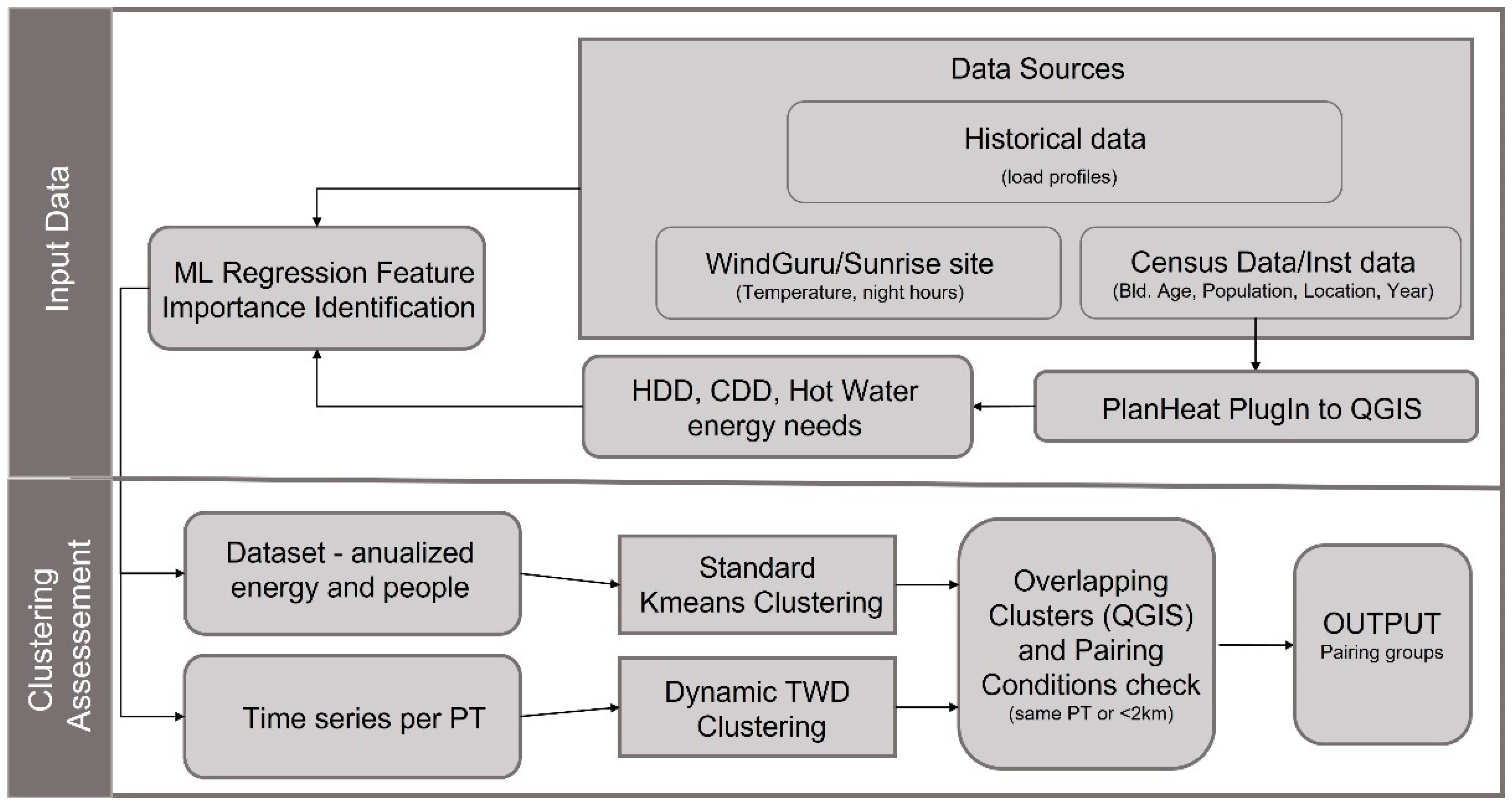

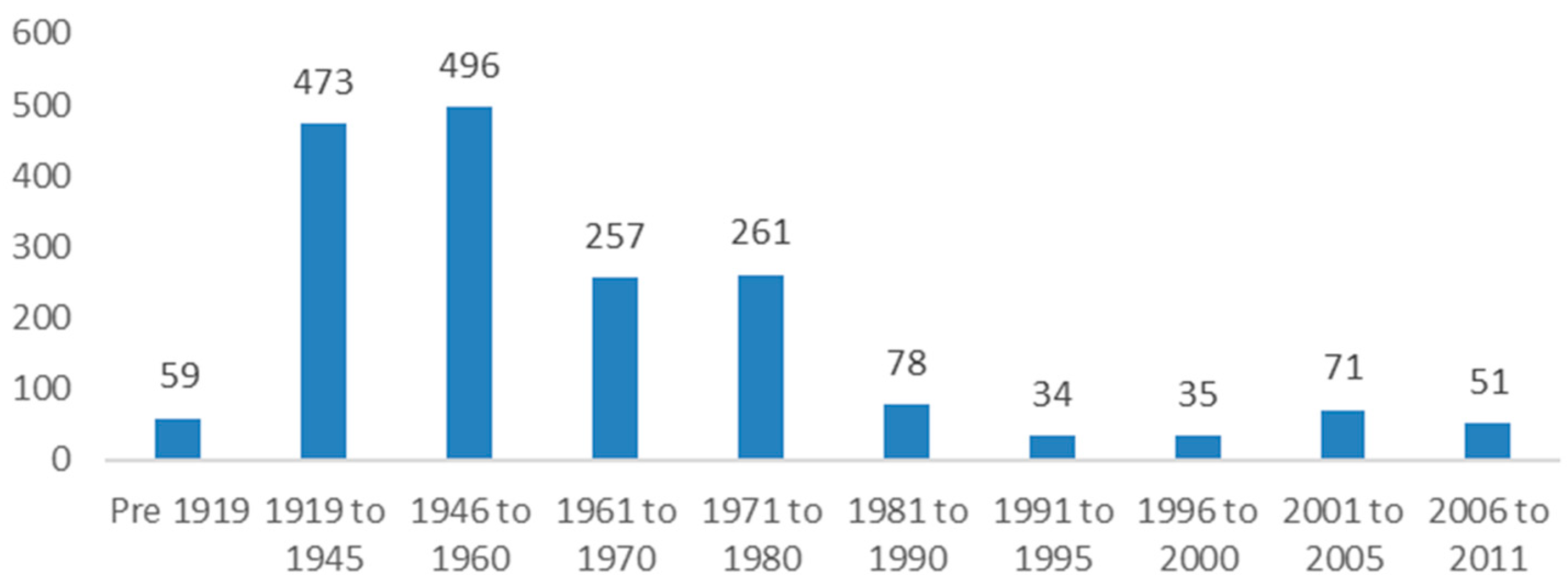
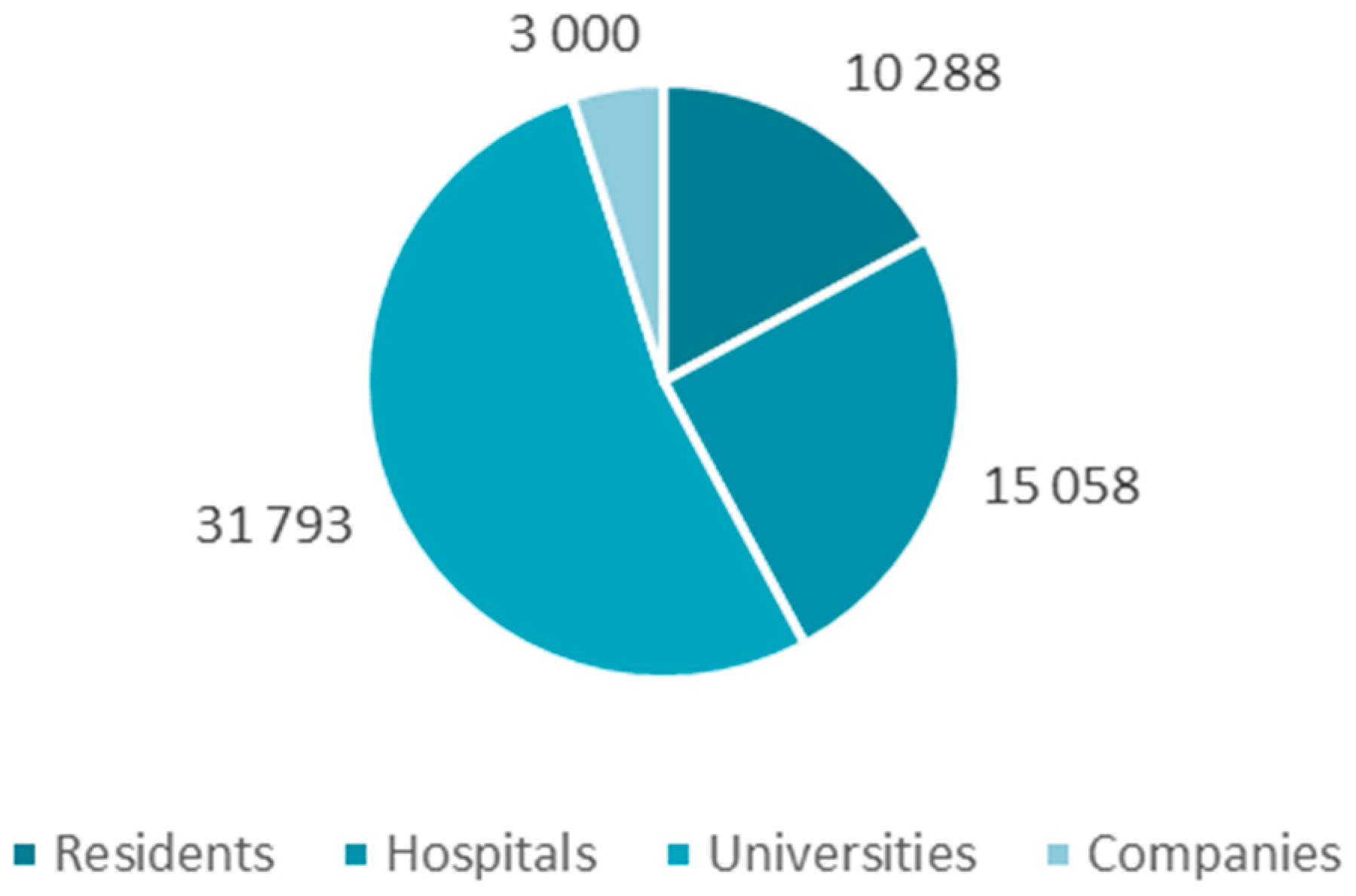
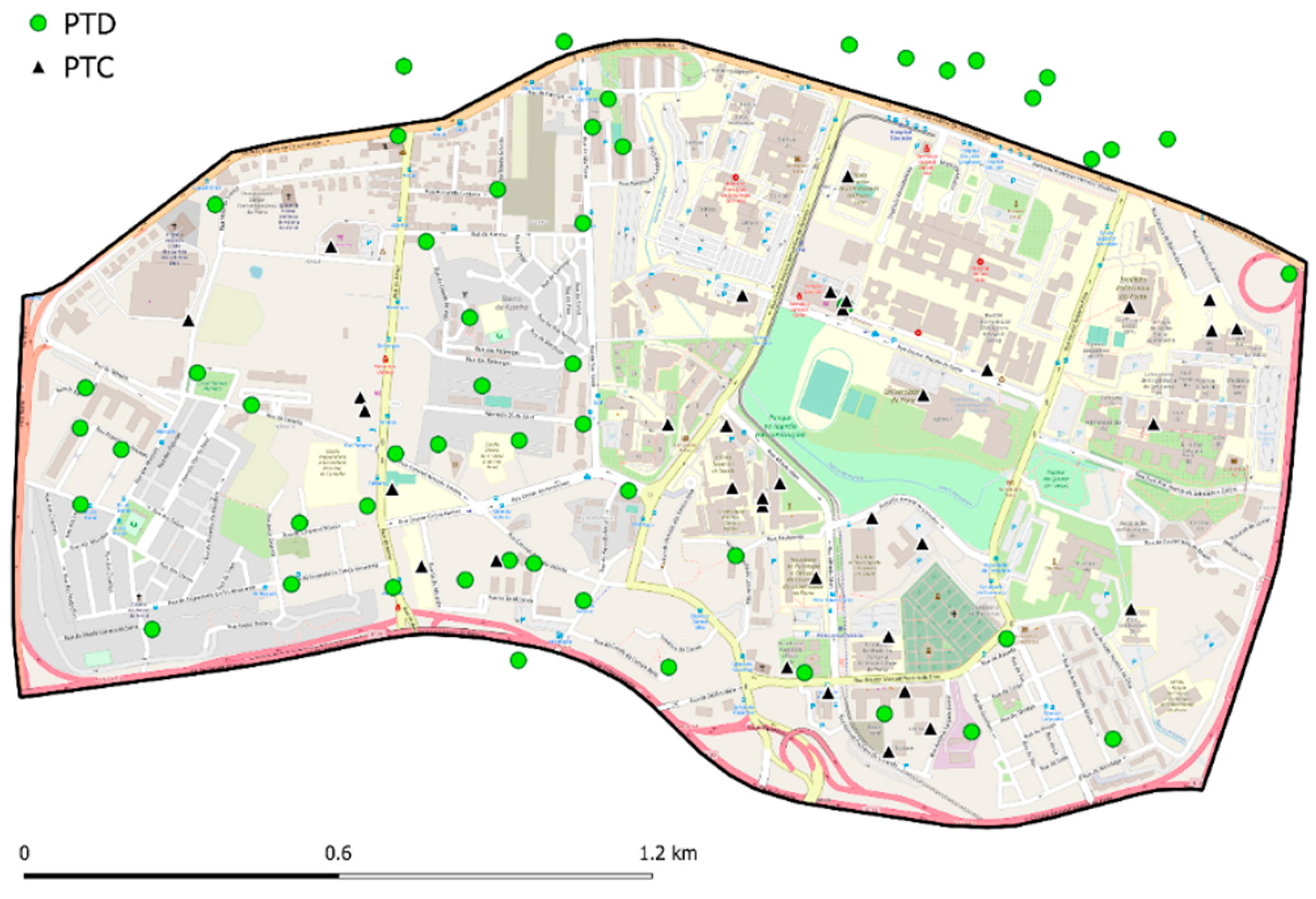

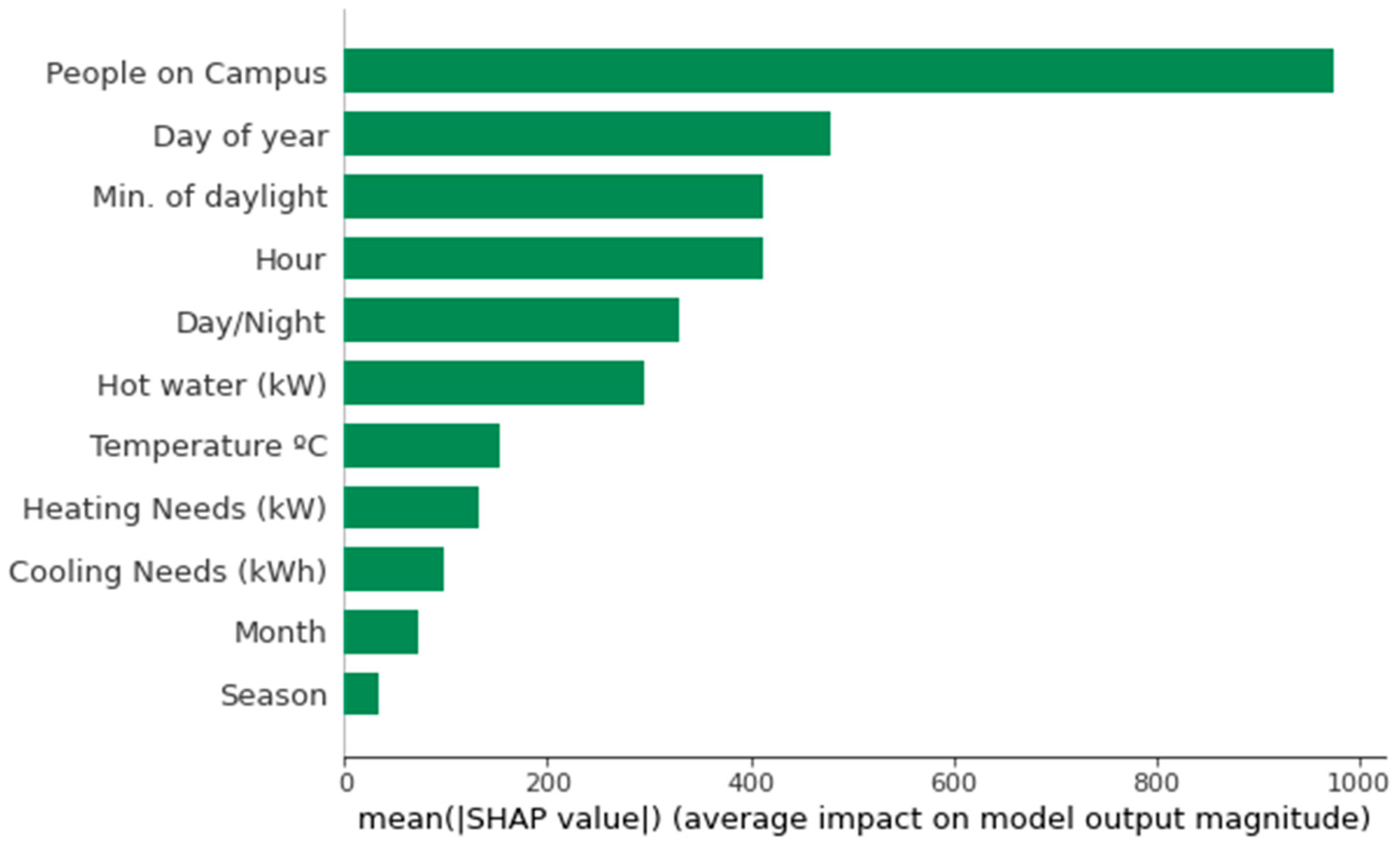
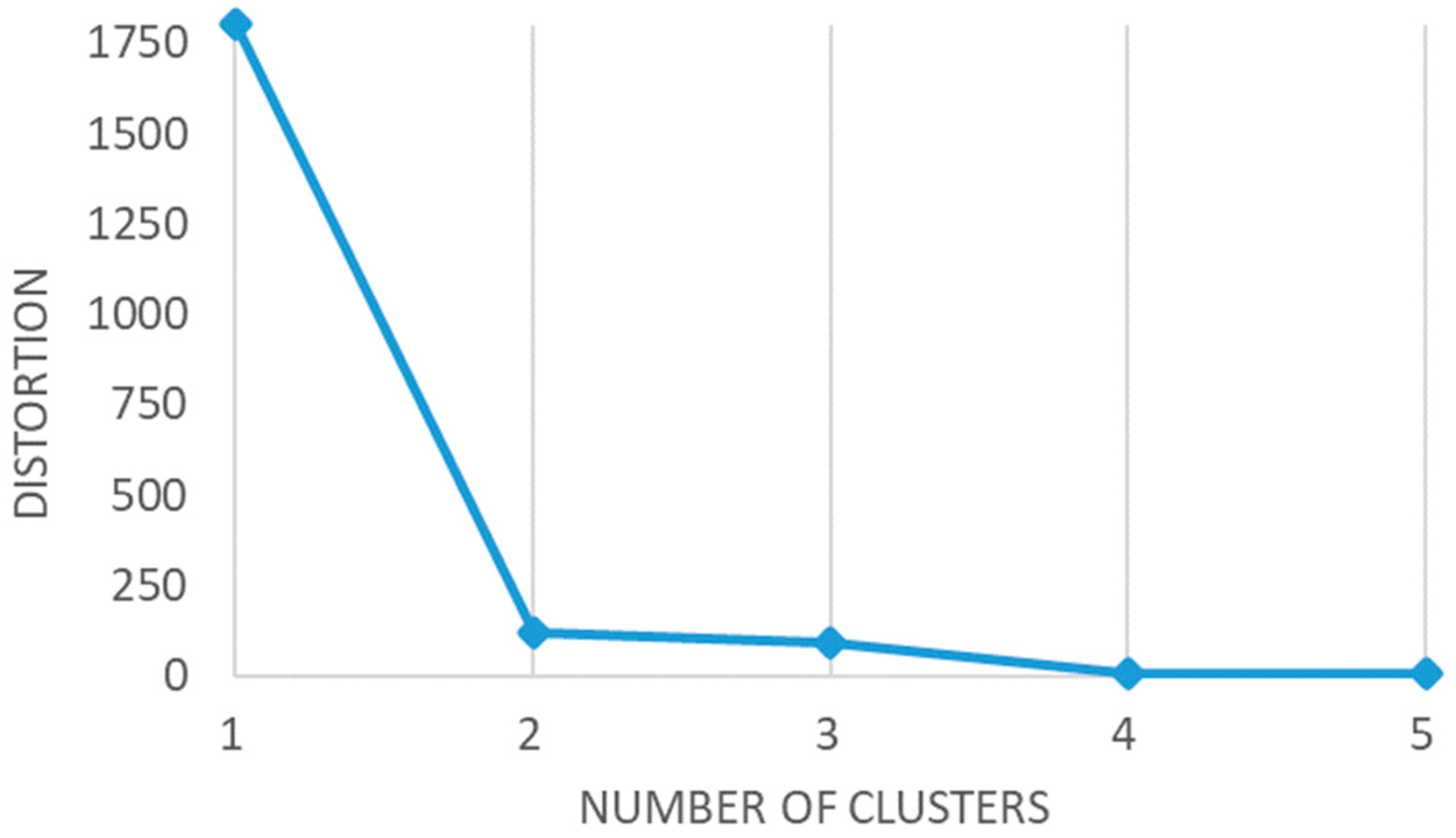

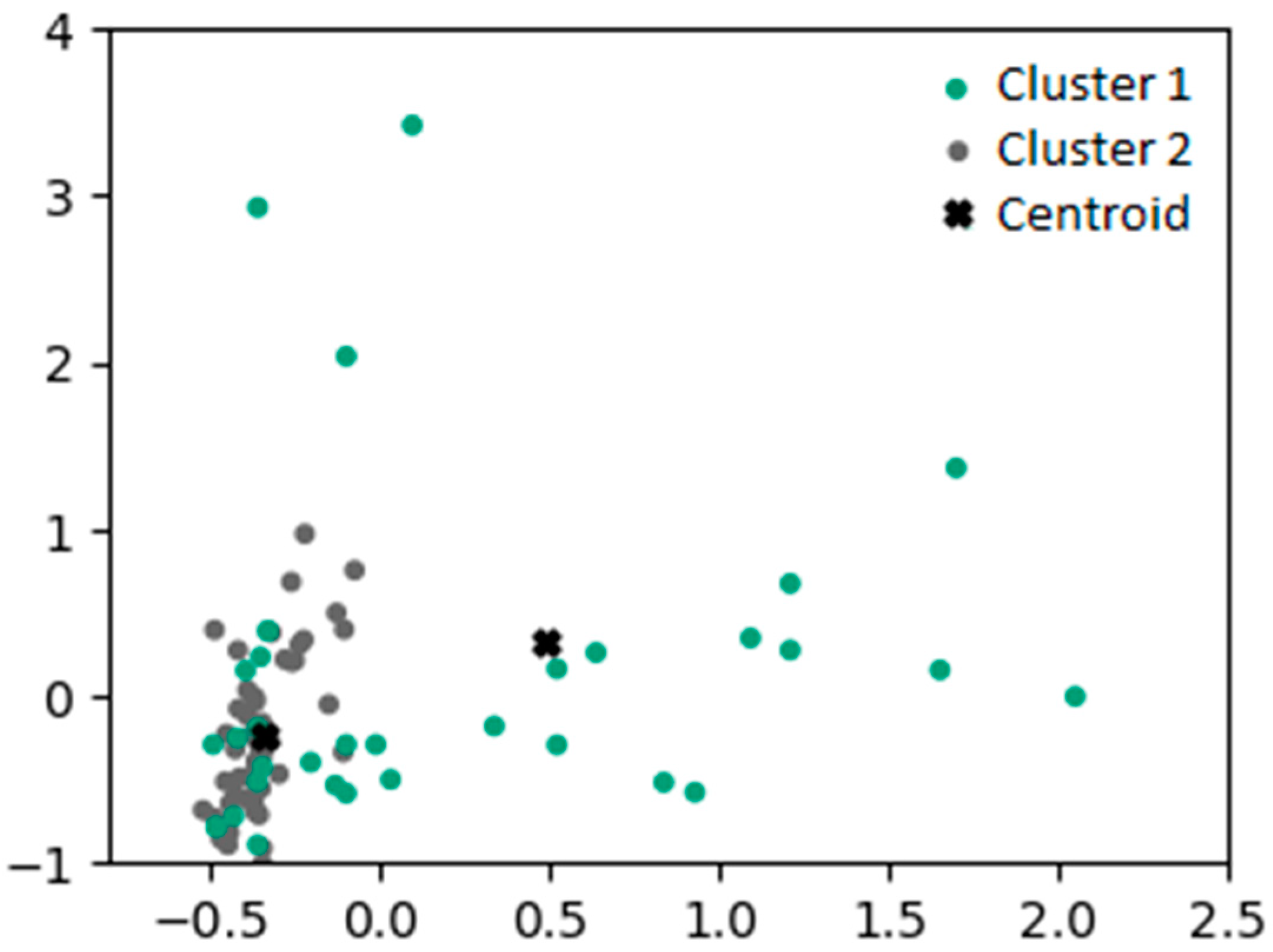

| Category | PT_ID |
|---|---|
| Domestic PT | PTD_1; PTD_3; PTD_4; PTD_5; PTD_6; PTD_7; PTD_8; PTD_9; PTD_10; PTD_11; PTD_12; PTD_13; PTD_14; PTD_15; PTD_16; PTD_17; PTD_18; PTD_19; PTD_20; PTD_21; PTD_22; PTD_23; PTD_24; PTD_25; PTD_26; PTD_28; PTD_29; PTD_30; PTD_31; PTD_32; PTD_33; PTD_34; PTD_35; PTD_36; PTD_37; PTD_38; PTD_39; PTD_40; PTD_41; PTD_42; PTD_43; PTD_44; PTD_45; PTD_46; PTD_47; PTD_50; PTD_51; PTD_52; PTD_54; PTD_55; PTD_56; PTD_59; PTD_60 |
| Commercial PT | UPORT; FPCEUP; FEUP; FEP; FADEUP; FMDUP; FMUP; ISEP; Continente; Pingo Doce; Froiz; Campus; IPP + ESE; ESENF; ESS_1; ESS_2; UPTEC; CLF_1; CLF_2; FFA; Portis; Hotel_B; PFIF; RES_UHUB; RES_UP; RES_SH; RES_LL; RES_VS1; RES_VS2; INESC; INEGI; i3S; IPATIMUP; IMINT (CISTER); AIC |
| Both from Cluster 1 | Surplus | Both from Cluster 2 | Surplus | From Clusters 1 and 2 | Surplus |
|---|---|---|---|---|---|
| PTD1-PTD3 | 6487.573983 | Portis-RES_UP | 7176.359 | PTD1-PTC_FPCEUP | 4707.002256 |
| PTD1-PTD4 | 7063.682571 | Portis-RES_UHUB | 7176.365 | PTD1-PTC_FMDUP | 4801.681378 |
| PTD1-PTD5 | 6765.905141 | Portis-RES_SH | 7176.372 | PTD1-PTC_CLF2 | 4838.0883 |
| PTD1-PTD6 | 6768.926405 | Portis-Hotel B | 7176.362 | PTD1-PTC_Portis | 6960.8778 |
| PTD1-PTD7 | 7299.579286 | Portis-CLF2 | 4773.183 | PTD1-PFIF | 6960.88241 |
| PTD1-PTD14 | 7303.262303 | Portis-FMDUP | 4688.797 | PTD1-RES_UP | 6960.875657 |
| Average kWh | 6948.154948 | Average kWh | 6361.24 | Average kWh | 5871.567967 |
Publisher’s Note: MDPI stays neutral with regard to jurisdictional claims in published maps and institutional affiliations. |
© 2022 by the authors. Licensee MDPI, Basel, Switzerland. This article is an open access article distributed under the terms and conditions of the Creative Commons Attribution (CC BY) license (https://creativecommons.org/licenses/by/4.0/).
Share and Cite
Lucas, A.; Carvalhosa, S. Renewable Energy Community Pairing Methodology Using Statistical Learning Applied to Georeferenced Energy Profiles. Energies 2022, 15, 4789. https://doi.org/10.3390/en15134789
Lucas A, Carvalhosa S. Renewable Energy Community Pairing Methodology Using Statistical Learning Applied to Georeferenced Energy Profiles. Energies. 2022; 15(13):4789. https://doi.org/10.3390/en15134789
Chicago/Turabian StyleLucas, Alexandre, and Salvador Carvalhosa. 2022. "Renewable Energy Community Pairing Methodology Using Statistical Learning Applied to Georeferenced Energy Profiles" Energies 15, no. 13: 4789. https://doi.org/10.3390/en15134789






